| Dance | U.S.A. | ||||||||||||||||||||||||||||||||||||||||||||||
BAFA © 2010. All material here is copyrighted. See conditions above. |
Joseph Houseal
|

Two members of Parnassus Dance Theater, 1994. Sharon Stern and Joseph Houseal. Photo: Sonja van Kerkhoff. See his website: http://www.parnassus-art.com | For seven years I lived in Kyoto, Japan studying and performing Noh dance-theatre, and this experience as well as the Bahá´í Teachings were influences in my life during the mid-eighties and early nineties. "Post-ballet" training, you might say. I was also influenced by many other aspects of our post-modern age and now work almost exclusively with endangered ancient dance forms, in particular of late, a project to record and preserve a threatened Buddhist dance form in Ladakh (adjacent to Tibet), as well as publishing articles and working on short art programs for televsion in Chicago where I currently live. |
I had my first ballet lesson at the age of 15, while a robust teen athlete. My teacher was the 92 year old dance-pioneer Margaret Howard. Later I studied and danced with the Washington Ballet as a scholarship student for two seasons before being given a rare opportunity to perform with the New York City Ballet where I encountered the choreographer George Balanchine and shared the stage with Mikhail Baryshnikov, albeit well behind him in a pack of peasants. I stopped this because I didn't want to be the paint; I wanted to be the painter. Besides, I didn't see many 30 year old men I wanted to turn into. So at the age of twenty-two, I entered St John's College in Annapolis, celebrated for its four-year non-elective course in "The Great Books," graduating in 1985.
|
| 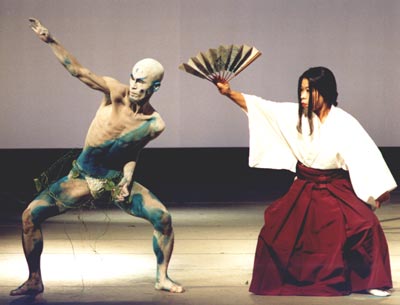 Katsura Kan (butoh dancer) and a Noh actor, Kamoi Eriko in Comic Itch (the actual Japanese title means: Birth Pangs of the Universe) produced by Joseph Houseal's company, Parnassus Dancetheater in 1989 in Kyoto, Japan. It involved over thirty performers from seven different countries.
Katsura Kan (butoh dancer) and a Noh actor, Kamoi Eriko in Comic Itch (the actual Japanese title means: Birth Pangs of the Universe) produced by Joseph Houseal's company, Parnassus Dancetheater in 1989 in Kyoto, Japan. It involved over thirty performers from seven different countries. |
| and then incorporate these so that the changed context is new and relevant.
We had a lot of fun doing these shows in Kyoto. The Japanese have a beautiful understanding: "To be an artist is to be enlightened." I don't think this means so much that all artists are enlightened as there aren't really so many true artists. Some of our shows were: Mid-Hell Smoke, written by the poet Michael Fournier which was a type of Noh play based on Dante's Inferno. Dante referred to a hell of lovers and we used Japanese Butoh dancers and Classical ballerinas to represent the damned lovers blowing through hell like "dried leaves in a maelstrom." The show also included a Kyogen (Noh-style comedy) master, actors from four different countries, and members of the Osaka medival music ensemble, Danceries. |
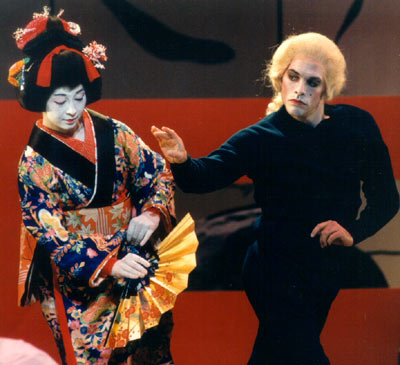 Fujima Kanso-o and Joseph Houseal performing in Good Manners.
Fujima Kanso-o and Joseph Houseal performing in Good Manners. |
|
We also spoke within our differing cultural languages so for example, I boasted to my new love, "I think therefore I am"(an equally famous and misplaced phrase) and so on.
and The Curse of Knowledge |
Our most successful show was Cosmic Itch which involved over thirty performers from seven different countries. It was a smash.
|
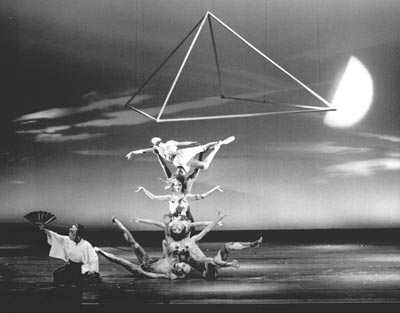 Above and below: Comic Itch (the actual Japanese title means: Birth Pangs of the Universe) produced by Joseph Houseal's company, Parnassus Dancetheater in 1989 in Kyoto, Japan. It involved over thirty performers from seven different countries.
Above and below: Comic Itch (the actual Japanese title means: Birth Pangs of the Universe) produced by Joseph Houseal's company, Parnassus Dancetheater in 1989 in Kyoto, Japan. It involved over thirty performers from seven different countries.
|
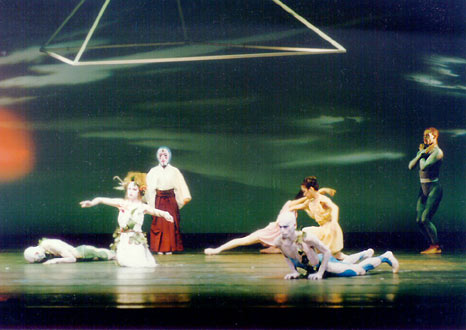 Comic Itch, performed by Parnassus Dancetheater in 1989.
Comic Itch, performed by Parnassus Dancetheater in 1989.
Joseph Houseal is on the far right. |
|
After that tour in the summer of 1993, I then created a solo piece for the celebration of the Birthday of Bahá'u'lláh. It was written by Carolyn Sparey-Gillies, principal violinist with the Scottish BBC Symphony, and performed at the Royal Academy in Glasgow. She said that the piece was about the path of all religions to unity, or the individual's journey to Bahá'u'lláh. She played viola while I danced. It was as intense and skillful as Carolyn was. What a pleasurable collaboration!
|
Also in 1993, I helped design the Bahá´í Summer Performing Arts Academy where I was the dance tutor. It was a great success on many levels, but perhaps not in the area of artistic excellence. At that time, a dummied-down version of the purpose of art was prevalent, and it caused tension. There was no question where I stood. God might love you if you rationalize lower standards with religion, but trust me, a good dance teacher won't.
|
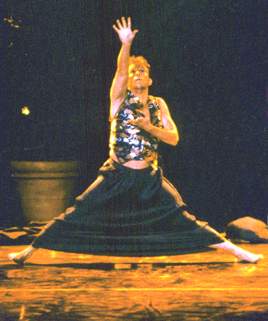
Once I Was a Willow performed on the 1997 Summer Solstice under a full moon at midnight by torchlight at the DeMenil estate on East Hampton, Long Island. Choreographed and performed by Joseph Houseal.
A solo dance incorporating Noh, Kabuki and 'martial modern' elements. Issey Miyake made the costume. The vest is made of Noh kimono brocade and had threads of bronze in it. Once I Was a Willow was inpired by the legendary Japanese poetess of antiquity, Komachi, and her response to a couple young monks who challenged her understanding of transience. She lived to be 100, half-mad, half-enlightened. Her response was Like a root-cut reed should the tide entice, I would go, I think. But now no stream asks, no tide beckons. Once I was a willow. |
|
 image to come -
image to come -
Dance in Ladakh, Himalayan India, 2000, photograph by Joseph Houseal. | “Although the musical accompaniment is largely with rhythm
instruments, drums and cymbals as well as enormous horns, the
musicians play cued by the solo and collective motions of the dancers. The dancers are guided by natural pulsations and the instructions the dancers follow as they execute steps are as such: "Ride like a piece of paper on a crashing wave" "Walk gracefully like a tiger through the forest" "Fly like a Garuda, a mythical bird-beast" "Move the head like a lion shaking a human victim in its mouth"
Excerpt from Joseph Houseal's article The Vanishing Dances of Ladakh. |
|
Arts Dialogue, Dintel 20, NL 7333 MC, Apeldoorn, The Netherlands email: bafa@bahai-library.com |